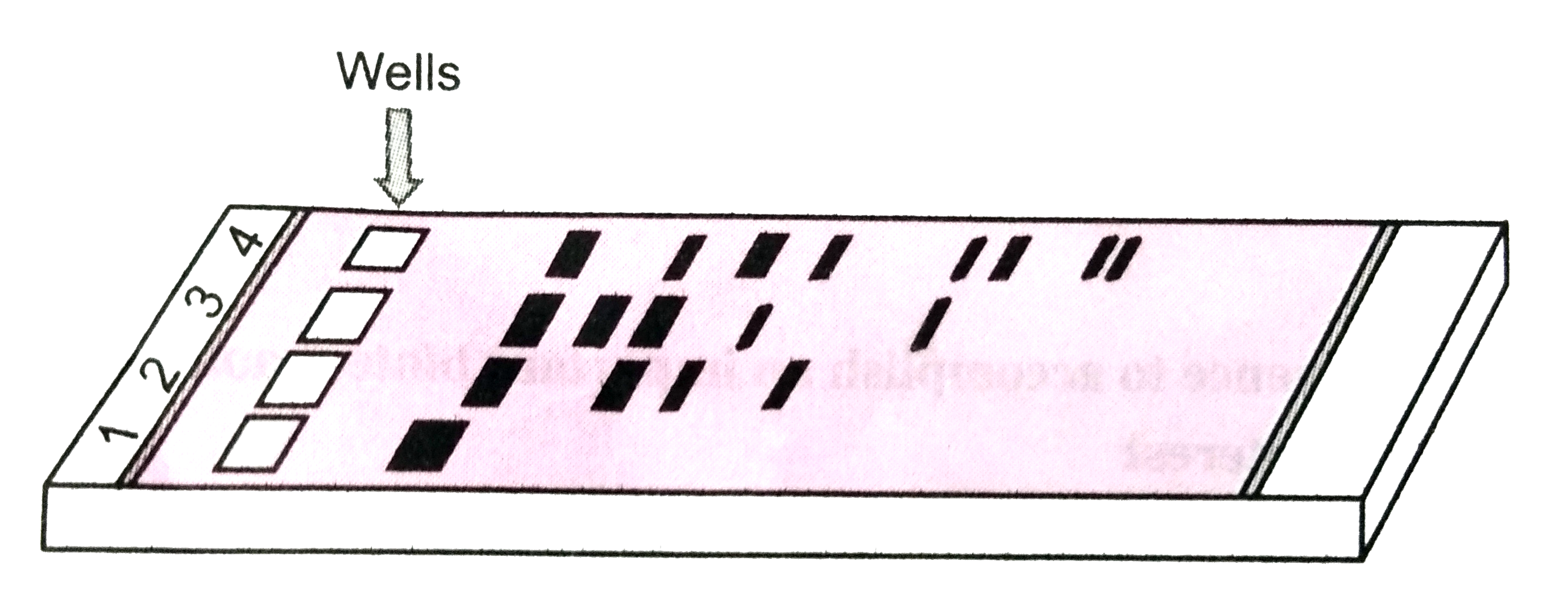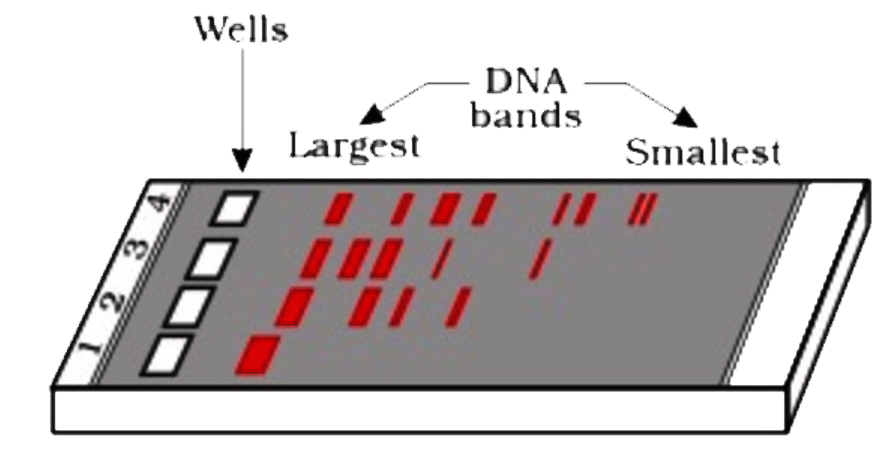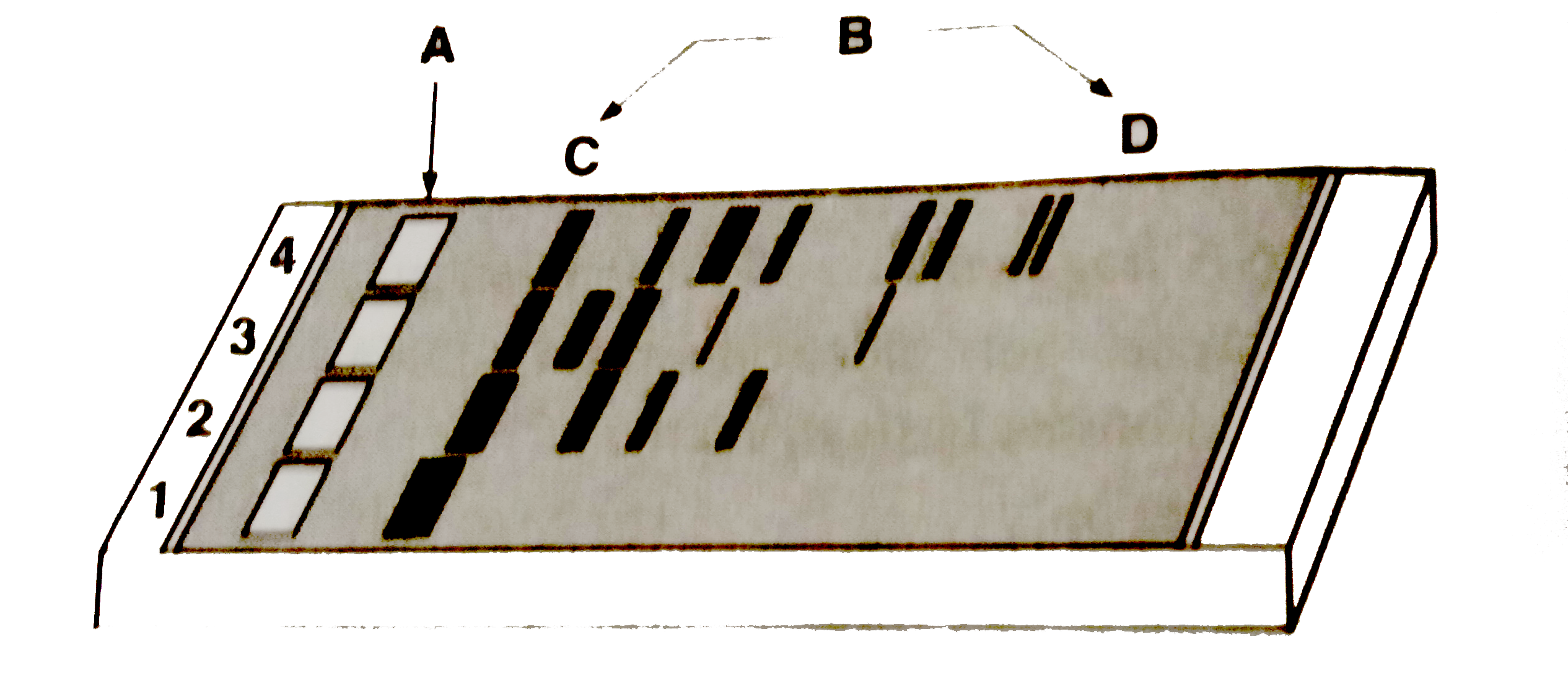a) How do DNA fragments migrate and resolve in a Gel electrophoresis?
b) How lane one is different from lane 2,3 and 4 in the GEL electrophoresis set up?
c) How pure DNA fragments are made observable in the visible light?

(a) The DNA fragment resolve according to their size through sieving effect provided by the agarose gel. Hence, the smaller the fragment size, the farther it moves.
(b) The given agarose gel electrophoresis shows migration of undigested DNA fragments in lane 1 and digested set of DNA fragment in lane 2 to 4.
(c) The separated DNA fragment can be visualized only after staining the DNA with a compound known as ethidium bromide followed by exposure to UV radiation.
Topper's Solved these Questions
- XII BOARDSBook:XII BOARDS PREVIOUS YEARChapter:XII BOARDSExercise:Section - D
Explore 15 Videos
- XII BOARDSBook:XII BOARDS PREVIOUS YEARChapter:XII BOARDSExercise:Delhi Board : Set II section -A
Explore 4 Videos
- XII BOARDSBook:XII BOARDS PREVIOUS YEARChapter:XII BOARDSExercise:Section - B
Explore 20 Videos
- SAMPLE PAPER 2019Book:XII BOARDS PREVIOUS YEARChapter:SAMPLE PAPER 2019Exercise:Section E Part B
Explore 3 Videos
Similar Questions
Knowledge Check
Study the given figure carefully and select the incorrect statements regarding this.

(i) It represents a typical agarose gel electrophoresis in which lane 1 contains undigested DNA
(ii) Smallest DNA bands are formed at A and largest DNA bands are formed at B
(iii) The separated DNA fragments can be visualized after staining in the visible light
(iv) The separated DNA bands are cut out from the agarose gel and extracted from the gel piece. this step is known as elution.AA and BBB and CCB and DDA and DStudy the given figure carefully and select the incorrect statements regarding this.

(i) It represents a typical agarose gel electrophoresis in which lane 1 contains undigested DNA
(ii) Smallest DNA bands are formed at A and largest DNA bands are formed at B
(iii) The separated DNA fragments can be visualized after staining in the visible light
(iv) The separated DNA bands are cut out from the agarose gel and extracted from the gel piece. this step is known as elution.A(i) and (ii)B(ii) and (iii)C(ii) and (iv)DPerson can see the bands without staining.Given below are four statements pertaining to separa- tion of DNA fragments using gel electrophoresis. Iden- tify the incorrect statements.
(a) DNA is negatively charged molecule and so it is loaded on gel towards the Anode terminal
(b) DNA fragments travel along the surface of the gel whose concentration does not affect movement of DNA.
(c) Smaller the size of DNA fragment larger is the dis- tance it travels through it.
(d) Pure DNA can be visualized directly by exposing UV radiation.
Choose correct answer from the options given belowA(a), (c) and (d)B(a), (b) and (c)C(b), (c) and (d)D(a), (b) and (d)
How do sol and gel differ from each other? Give one example for each.
View SolutionGiven diagram showing a typical agarose gel electrophoresis showing migration of DNA fragments . The undigested DNA fragment will be present in the lane

View SolutionAfter electrophoresis the separated DNA fragment can be vishualised ethidium bromide gel exposed UV light . These DNA fragments appear as _______ coloured bands :
View SolutionA typical agarose gel electrophoresis showing migration of undigested (lane 1) and digested set DNA fragments (lane 2 to 4) is show below. Identify A, B ,C and D by selecting the option :

View SolutionGel electrophoresis, a technique used to separate DNA fragments after the function of restriction endonuclease. Sundeep take the help of his friend Sushi by asking question , how can we see DNA fragments after their separation ?
The answer is
View Solution